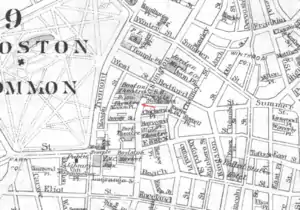Bijou Theatre (Boston)
The Bijou Theatre (1882–1943) in Boston, Massachusetts, occupied the second floor of 545 Washington Street near today's Theatre District.[1][2] Architect George Wetherell designed the space, described by a contemporary reviewer as "dainty."[3][4] Proprietors included Edward Hastings, George Tyler, and B.F. Keith.[5][6] Around the 1900s, it featured a "staircase of heavy glass under which flowed an illuminated waterfall."[7] The Bijou "closed 31 December 1943 and was razed in 1951."[8] The building's facade still exists.[9] It is currently a pending Boston Landmark by the Boston Landmarks Commission.
Bijou Opera House, Bijou Dream Theatre, B.F. Keith's Bijou Theatre, RKO Bijou Theatre, Intown Theatre | |
 Bijou interior, 19th century | |
| Address | 545 Washington Street Boston, Massachusetts United States |
|---|---|
| Operator | Emerson College |
| Construction | |
| Opened | December 11, 1882 |
| Closed | 1943 |
| Years active | 1882-1943 |
| Architect | Bradlee, Winslow & Wetherell |
Background
The building was constructed in 1836 as The Lion Theatre, and in 1839 was renamed The Melodeon. In 1878, the name was changed to The Gaiety. It was also named The Mechanics Institute, Melodeon Varieties, and the New Melodeon. The Gaiety was purchased by George H. Tyler (who also ran The Park Theatre) and by Frederick Vokes, who had renovated the Gaiety, and wanted to rename it the Bijou Theatre. Vokes would relinquish his share, and Tyler would replace him with E.H. and T.N. Hastings. The Bijou officially opened on December 18, 1882.[10]
The Bijou

The new theatre opened on December 18, 1882 with the Arthur Sullivan and W.S. Gilbert (Gilbert and Sullivan) comic opera Iolanthe. By September 27, 1886, the theatre became owned by B.F. Keith and George R. Batcheller.[10] On March 24, 1894, Keith opened a theatre next the Bijou named "B.F. Keith’s Theatre". In 1901, it was renamed the "Bijou Opera House". The Bijou would later be named "Bijou Dream" when it became a movie house in 1927, and also became known as Intown sometime after that.[11]
The Bijou was a distinct theatre for a couple of reasons. The Bijou was the first theatre in the United States to be elementarily lighted by electricity, which Thomas Edison personally installed and supervised.[10][12] It also was unique for the fact that it did not have a traditional exit to the outside. Since it was on the second floor, the exits led to the lobbies of the two surrounding theatres, the B.F. Keith Theatre (later the Normandie and Laffmovie) and the newer Keith Memorial (later known as the Savoy and is now the Boston Opera House). After the tragic 1942 Cocoanut Grove fire (492 deaths), Boston heavily enforced new fire laws, and since the Bijou did not have adequate exits, it was forced to close.[11]
The Bijou was razed to the orchestra and stage floors, which became the roof of the stores below. Most of what remained of the Bijou building was demolished in 2008, but Emerson College bought the property and plans to make the Bijou and Paramount Theatre into theatres and dormitories.[11]
Images
 Detail of 1886 map of Boston, showing the Bijou adjacent to the Boston Theatre
Detail of 1886 map of Boston, showing the Bijou adjacent to the Boston Theatre Film projection room, 1911
Film projection room, 1911 Advertisement, 1915, for Frank Keenan, Marie Tempest, Bijou String Quartet
Advertisement, 1915, for Frank Keenan, Marie Tempest, Bijou String Quartet Facade of former Bijou in 2011; between Paramount Theatre (at left), and Boston Opera House (at right)
Facade of former Bijou in 2011; between Paramount Theatre (at left), and Boston Opera House (at right)
Variant names
References
- Boston Almanac and Business Directory. 1887, 1891, 1894
- Charles Baxton (1884), Boston and the Back Bay, Boston, Mass: Reed & Lincoln, OL 13997009M
- Richard Herndon (1892), Boston of To-Day, Boston: Post Pub. Co., OCLC 4430662, OL 7162628M
- U.S. Dept. of the Interior. National Register of Historic Places Inventory - Nomination Form: [pdfhost.focus.nps.gov/docs/NRHP/Text/64000273.pdf Boston Theatre Multiple Resource Area]. 1979. Retrieved 2012-03-16
- Historical review of the Boston Bijou Theatre: with the original casts of all the operas that have been produced at the Bijou, Boston: Edward O. Skelton, 1884, OL 24140253M
- "A High-Class Motion Picture House." Photo-Era v.27, no.2, August 1911
- Boston Opera House. The Boston Opera House Site Archived 2013-12-24 at the Wayback Machine. Retrieved 2012-03-16
- Frank Cullen. Vaudeville old & new: an encyclopedia of variety performances in America. NY: Routledge, 2004
- Adams House Annex, no.543-547 Washington Street, Boston, USA. "Facade built 1858-1850; interior completely remodeled 1881-82." Boston Redevelopment Authority. (1987), Midtown cultural district plan: historic building survey
- "Boston Athenæum Theater History | Boston Athenæum".
- "Bijou Theatre in Boston, MA - Cinema Treasures".
- Edison Bulb in the Spotlight, Harvard Houghton Library Blog
- Wilson's annual reference book ... Greater Boston, [Boston?], 1904, OL 14048417M
{{citation}}: CS1 maint: location missing publisher (link) - Clark's Boston Blue Book, 1909
- Life, Jan. 10, 1938
External links
- Harvard Theatre Collection, Houghton Library, Harvard University. Boston Bijou Theatre Company records: Guide
- Boston Athenaeum. Theater History Archived 2021-04-14 at the Wayback Machine. Bijou Theatre (1882- 1952), 545 Washington Street
- Historic Boston Inc. Adams House Annex/Bijou Theater, 543-547 Washington Street
- Boston Landmarks Commission. Photo of 543-547 Washington Street, Boston, 20th century